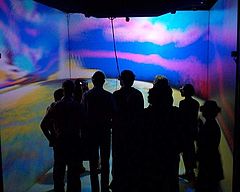- Daniel J. Sandin
-
For other uses, see Sandin (disambiguation).
Daniel J. Sandin (born 1942) is a video and computer graphics artist/researcher. He is a Professor Emeritus of the School of Art & Design, University of Illinois at Chicago, and Co-director of the Electronic Visualization Laboratory at the University of Illinois at Chicago.[1] He is an internationally recognized pioneer in computer graphics, electronic art and visualization.[citation needed]
Contents
Biography
Dan Sandin received his B.A. in Natural Sciences from Shimer College, IL in 1964 and his M.S. in Physics from the University of Wisconsin–Madison in 1967.[2] He became interested in video in 1967, while helping to organize student demonstrations at the University of Illinois.
In 1969, he moved from the University of Wisconsin–Madison to the University of Illinois at Chicago after his presentation at the Smithsonian of "Glowflow", a computer controlled light and sound system, created with Myron Krueger. His major achievements were a series of projects Glowflow (1969), Sandin Image Processor (IP) (1971–1973), Sayre Glove (1977), PHSColograms (1988), CAVE (1991) and ImmersaDesk and Infinity Wall.
Dan Sandin received several awards. The Guggenheim Fellowships awarded in 1978, the National Endowment for the Arts in 1980, the Rockefeller Foundation Video Fellowship in 1981, the Inventor of the Year from the University of Illinois in 2000 and the Rockefeller Foundation Media Arts Fellowship in 2002.
Work
Dan Sandin has said that his career has three main objectives:[citation needed]
- the design of electronic instruments for visual performance and personal growth;
- the development of educational facilities and programs related to the use of electronic screens; and
- the production and exhibition of visual works for personal expressive reasons.
Sandin Image Processor
From 1971 to 1973, he designed the Sandin Image Processor, a patch programmable analog computer for real-time manipulation of video inputs through the control of the grey level information. This modular design was based on the Moog synthesizer. With Tom DeFanti, he would combine it with real-time computer graphics and synthesized music and perform visual concerts. He has performed worldwide and has received grants in support of his work from the Rockefeller Foundation (1981), the National Science Foundation, the National Endowment for the Arts (1980) and the Guggenheim Foundation (1978). His piece "Spiral PTL" was one of the first pieces included in the Museum of Modern Art's video art collection.
The Sayre Glove
In 1977, with Tom DeFanti and Rich Sayre, he designed the Sayre Glove, the first data glove, as part of a grant from the National Endowment for the Arts. This device used light based sensors with flexible tubes with a light source at one end and a photocell at the other. As the fingers were bent, the amount of light that hit the photocells varied, thus providing a measure of finger flexion. It was mainly used to manipulate sliders, but was lightweight and inexpensive.
PHSColograms
Main article: PHSCologramBy 1988, Sandin was working on a type of digital photography called PHSColograms; a system whereby a number of still images were situated in an autostereoscopic manner and back-projected with light. The effect was very similar to holograms and many times viewers would mistake them as such. The initial system supported roughly 13 images but further improvements now could easily allow 100 such images to be used. This system was designed primarily for use in the medical field where these quasi-3D images could benefit surgeons.
Cave Automatic Virtual Environment
 A group of people viewing Sandin's From Death's Door to the Garden Peninsula in the CAVE at Ars Electronica '99
A group of people viewing Sandin's From Death's Door to the Garden Peninsula in the CAVE at Ars Electronica '99
In 1991, in conjunction with Tom DeFanti and graduate students, he designed the CAVE system. This is an immersive system that is the current standard for Virtual Reality systems. The normal full system consists of projections screens along the front, side and floor axes, and a tracking system for the "user". Although they used the recursive acronym Cave Automatic Virtual Environment for the CAVE system, the name also refers to Plato's "Republic" and "The Allegory of the Cave" where he explored the concepts of reality and human perception.
Since then there have been a couple off-shoots of the CAVE technology: ImmersaDesk and Infinity Wall. The ImmersaDesk is a semi-immersive system, resembling a drafting table, while the Infinity Wall is designed to cater to an entire room of people, such as a conference room.
Works
- 1973. "5 Minute Romp through the Image Processor". With Phil Morton.
- 1975. "Wandawega Waters".
- 1974. "Poop for the NCC". With Tom DeFanti.
- 1974. "Triangle in Front of Square in Front of Circle in Front of Triangle".
- 1980. "Spiral PTL". With Tom Defanti and Mimi Shevitz, in the collection of the Museum of Modern Art in New York.
- 1990. "A Volume of Two-Dimensional Julia Sets".
- 1995. "The Kinetic Sculpture Garden".
- 1996. "The Oort Continuum".
- 1997. "Poverty Island With Video Skies".
- 1999. "From Death's Door to the Garden Peninsula".
- 2001. "Alive on the Grid".
References
- ^ "Daniel J. Sandin". EVL. http://www.evl.uic.edu/core.php?mod=4&type=5&indi=11. Retrieved 6 December 2010.
- ^ Annie Koval (2011-03-16). "Visualization pioneer creates virtual worlds". Medill Reports. http://news.medill.northwestern.edu/chicago/news.aspx?id=183397. Retrieved 2011-03-16.
External links
Categories:- 1942 births
- American artists
- Computer graphics professionals
- Digital artists
- Living people
- Guggenheim Fellows
- Video artists
- Virtual reality pioneers
- University of Illinois at Chicago faculty
- Shimer College alumni
Wikimedia Foundation. 2010.

